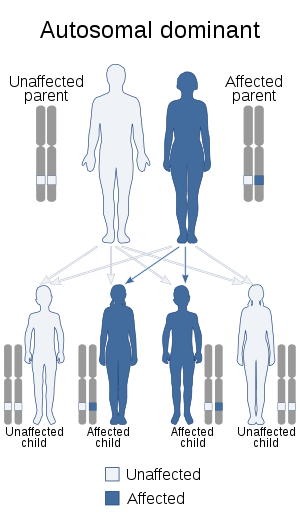Coffin–Siris syndrome
Coffin–Siris Syndrome is a rare genetic disorder that causes developmental delays and absent fifth finger and toe nails. There had been 31 reported cases by 1991.[1] The number of occurrences since then has grown and is now reported to be around 80.[2]
| Coffin–Siris syndrome | |
|---|---|
| Other names | Dwarfism-Onychodysplasia, Fifth Digit Syndrome, Mental Retardation with Hypoplastic 5th Fingernails and Toenails, Short Stature-Onychodysplasia |
 | |
| Coffin–Siris syndrome is inherited in an autosomal dominant manner | |
The differential includes Nicolaides–Baraitser syndrome.[3]
Presentation
- mild to severe intellectual disability,[4][5] also called "developmental disability"[6]
- short fifth digits with hypoplastic or absent nails
- low birth weight
- feeding difficulties upon birth
- frequent respiratory infections during infancy
- hypotonia
- joint laxity
- delayed bone age
- microcephaly
- coarse facial features, including wide nose, wide mouth, and thick eyebrows and lashes
Causes
Autosomal dominant inheritance is the most likely, usually by de novo mutation.
This syndrome has been associated with mutations in the ARID1B gene.[7]
Mutations in SOX11 are associated to this syndrome.[8]
A second gene that has been associated with this syndrome is the AT-rich interaction domain 2 (ARID2) gene.[9]
The diagnosis is generally based on the presence of major and at least one minor clinical sign and can be confirmed by molecular genetic testing of the causative genes. Recent studies revealed that fifth finger nail/distal phalanx hypoplasia or aplasia is not a mandatory finding.
Diagnosis
Treatment
There is no known cure or standard for treatment. Treatment is based on symptoms and may include physical, occupational and speech therapy and educational services as well.
References
- Levy P, Baraitser M (May 1991). "Coffin-Siris syndrome". Journal of Medical Genetics. 28 (5): 338–41. doi:10.1136/jmg.28.5.338. PMC 1016855. PMID 1865473.
- metrowebukmetro (2008-10-13). "Twisted spine girl back playing football". Metro. Retrieved 13 June 2015.
- Sousa SB, Abdul-Rahman OA, Bottani A, Cormier-Daire V, Fryer A, Gillessen-Kaesbach G, Horn D, Josifova D, Kuechler A, Lees M, MacDermot K, Magee A, Morice-Picard F, Rosser E, Sarkar A, Shannon N, Stolte-Dijkstra I, Verloes A, Wakeling E, Wilson L, Hennekam RC (August 2009). "Nicolaides-Baraitser syndrome: Delineation of the phenotype". American Journal of Medical Genetics. Part A. 149A (8): 1628–40. doi:10.1002/ajmg.a.32956. PMID 19606471.
- "Coffin-Siris syndrome". Genetics Home Reference. 8 June 2015. Retrieved 13 June 2015.
- Cha AE (4 June 2015). "NIH researchers sequence healthy volunteers' DNA and find they aren't so healthy after all". Washington Post. Retrieved 13 June 2015.
- "Greenville: A home of one's own - Ledger Transcript". Ledger Transcript. 2015-05-14. Retrieved 13 June 2015.
- Vals MA, Õiglane-Shlik E, Nõukas M, Shor R, Peet A, Kals M, Kivistik PA, Metspalu A, Õunap K (November 2014). "Coffin-Siris Syndrome with obesity, macrocephaly, hepatomegaly and hyperinsulinism caused by a mutation in the ARID1B gene". European Journal of Human Genetics. 22 (11): 1327–9. doi:10.1038/ejhg.2014.25. PMC 4200437. PMID 24569609.
- Tsurusaki Y, Koshimizu E, Ohashi H, Phadke S, Kou I, Shiina M, Suzuki T, Okamoto N, Imamura S, Yamashita M, Watanabe S, Yoshiura K, Kodera H, Miyatake S, Nakashima M, Saitsu H, Ogata K, Ikegawa S, Miyake N, Matsumoto N (June 2014). "De novo SOX11 mutations cause Coffin-Siris syndrome". Nature Communications. 5: 4011. Bibcode:2014NatCo...5.4011T. doi:10.1038/ncomms5011. PMID 24886874.
- Gazdagh G, Blyth M, Scurr I, Turnpenny PD, Mehta SG, Armstrong R, McEntagart M, Newbury-Ecob R, Tobias ES, Joss S (April 2018). "Extending the clinical and genetic spectrum of ARID2 related intellectual disability. A case series of 7 patients" (PDF). European Journal of Medical Genetics. 62 (1): 27–34. doi:10.1016/j.ejmg.2018.04.014. PMID 29698805.
External links
- Coffin–Siris syndrome on Orphanet
- synd/3426 at Who Named It?
| Classification | |
|---|---|
| External resources |